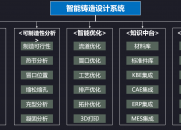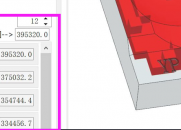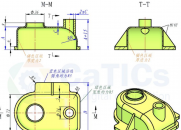|
|
 leaf
发表于 2014-11-26 07:50:53
leaf
发表于 2014-11-26 07:50:53
tag_t newPartTag = NULL_TAG;( Y9 Q, c& f! Q3 X- D! m4 h
tag_t cylTag = NULL_TAG;
6 ]4 V) O0 `6 J" z tag_t bodyTag = NULL_TAG;
3 B b* t# ]( Q& c: u. Y double cylOrigin[3] = {20, 30, 40}; Y( J' b3 Z7 R4 u# g1 h0 C
char cylDiam[256] = "50";
) t, y8 d* `) y9 r, Z7 v7 [ double cylDirection[3] = {0, 0 ,1};8 w' @+ {, A% `) G
double height = 60;
# S. G) u0 `$ i; j& L5 d' B : j1 b) d$ J% [: g$ p6 Q! q
5 {' M$ L+ T" }6 b' G
char cylHeight[256];
% Q/ Y; e! I, p/ x. ? sprintf_s(cylHeight, sizeof(cylHeight), "%f", height);
& e1 ~; b5 e6 h8 Z/ }3 i2 B //创建part
0 p: ]) `+ U% e6 W$ E4 }6 c& S UF_CALL(UF_PART_new("D:\\leaf.part", 1, &newPartTag));
7 ?/ ` S9 i& ?7 R5 H. s //创建圆柱
" [0 ` s) L1 z: Q& b UF_CALL(UF_MODL_create_cyl1(UF_NULLSIGN, cylOrigin, cylHeight, cylDiam, cylDirection, &cylTag));
$ B) i6 k' v; w. s2 z% Q9 }5 F //获取圆柱特征所在的体
1 y9 h& K* ~- C2 U, @' T$ R UF_CALL(UF_MODL_ask_feat_body(cylTag,&bodyTag));# F( o' K9 `& D5 X
//获取体上的边
/ t' H5 @5 k2 E0 \ uf_list_p_t edge_list ;( i4 w, F# F4 l8 W7 u! g5 \
UF_CALL(UF_MODL_ask_body_edges(bodyTag, &edge_list));
) U% \. T( O! o4 R# ^ //得到边的数量
g; t2 L* n8 {) E' A2 S# I+ z int edgeCount = 0;( \ Z. W( L* ^9 \
UF_CALL(UF_MODL_ask_list_count(edge_list, &edgeCount));* U( I) s& }; t6 Z+ }
//打印边的数量
: f, S. @1 X* N: \) }3 a/ g5 S5 } char cCount[256];, S" o; \- U3 W7 s
sprintf_s(cCount, sizeof(cCount), "cylinder实体上的边的数量:%d", edgeCount);5 ?) f+ M- O1 V" B
uc1601(cCount, 1);
2 A# y/ F/ q4 c7 b* S ^! ]: Z # k1 c7 [7 [( g1 w6 D
int error;
- v6 f, f1 j# X2 {) B/ x( o double (*point_coords)[3];
+ x+ t/ o# K) A5 r8 Z; B) G: ~5 j: R point_coords= (double (*)[3]) UF_allocate_memory(edgeCount * sizeof(double [3]), &error );+ A) I* H: Z" J8 o6 a
//获取圆柱的上两条边的圆心
+ z8 F) f: p7 c4 |2 N! a- J2 k int i = 0;
2 ]( T2 T7 p( m5 l! T4 k+ F tag_t curveOriginTag = NULL_TAG;
8 w; V: L0 C# E) }3 q. J2 z for (i; i < edgeCount; i++)
; C$ J- b4 y' I% L, @* ]; \) f {7 U* u5 n# R) n5 C F& A. u# j4 s8 [, `/ C
UF_CALL(UF_MODL_ask_list_item(edge_list, i, &curveOriginTag));
6 F: U, i- y4 d) Q. J UF_CALL(UF_CURVE_ask_centroid(curveOriginTag, point_coords[i]));
0 l5 _8 f5 S# O; X4 T }
( y% p/ e" d$ ]8 q- |7 g" a //将圆心存放到直线起始点的链表中- r9 J- H5 l7 x, r! o& r( ~0 ?: D
UF_CURVE_line_p_t line_coords;
! M% R, I3 E$ r* U line_coords= (UF_CURVE_line_p_t ) UF_allocate_memory(edgeCount * sizeof(double [3]), &error );; `3 h! `! |% e: L
line_coords->start_point[0] = point_coords[0][0];
! v) b+ D, ~" L% t1 Q line_coords->start_point[1] = point_coords[0][1];
- H7 Y9 `* n5 K1 [; D/ T line_coords->start_point[2] = point_coords[0][2];( v0 }. ]$ m9 L9 p( H: v5 K2 m
line_coords->end_point[0] = point_coords[1][0];3 }8 E2 l0 ]( I' \ ?
line_coords->end_point[1] = point_coords[1][1];
$ O2 O* l6 ^, \4 r/ V9 ^: h }7 U line_coords->end_point[2] = point_coords[1][2];
* S" P6 n) H `- N3 x$ k- ~
$ ]' U( m# A0 G4 F2 U( n) i tag_t lineTag = NULL_TAG;
1 n8 N9 G8 B7 L) N* T. i+ ~ 7 w8 |5 H L+ I5 G" V. t: C& q
//创建直线
; H+ H9 P3 @: F& w0 P UF_CALL(UF_CURVE_create_line(line_coords, &lineTag));
: f* U: H0 _) E! k# u i+ P1 j! _! n
//打印直线的端点
3 z5 E$ X, `9 R+ ^ l# n' ~ char msg[256];
6 C9 `( b0 D& W1 I. y/ Q( @* u+ j sprintf_s(msg, sizeof(msg), "创建的直线的起点是:%f、%f、%f,\n终点是:%f、%f、%f.",$ v# s8 \$ k# `+ i6 o( { M
line_coords->start_point[0],4 `, v0 g+ N3 E4 ?; h
line_coords->start_point[1],' H+ b# c4 q/ M/ K7 I2 _' k
line_coords->start_point[2],1 q/ g6 h d' S E5 j
line_coords->end_point[0],
$ j0 E5 K+ V6 Z/ ?% ^1 r line_coords->end_point[1],
+ y* N7 w: O0 t3 W- l line_coords->end_point[2]);
. P+ X5 z" \+ z+ E, V3 T UF_CALL(UF_UI_open_listing_window());
& M' A! n7 q* c% V0 y; n UF_CALL(UF_UI_write_listing_window(msg));
3 W4 V& _& t" w //UF_CALL(UF_UI_close_listing_window());
5 ~ @9 P* N* l5 L
$ a9 Y- g1 X# X: O: d4 T! y7 } //释放动态内存7 S5 I5 ~! G8 M+ [
UF_MODL_delete_list(&edge_list);
+ p6 G7 Y0 ^2 M& e. E# s* T UF_free(point_coords);
g. h* n8 O9 L! M, K UF_free(line_coords);8 q% N# @% j* ?5 d7 d
) }6 T( _, G O( X- S9 Q UF_PART_save();
+ e- X, s1 k: ~+ g UF_PART_close_all(); |
评分
-
查看全部评分
|

















